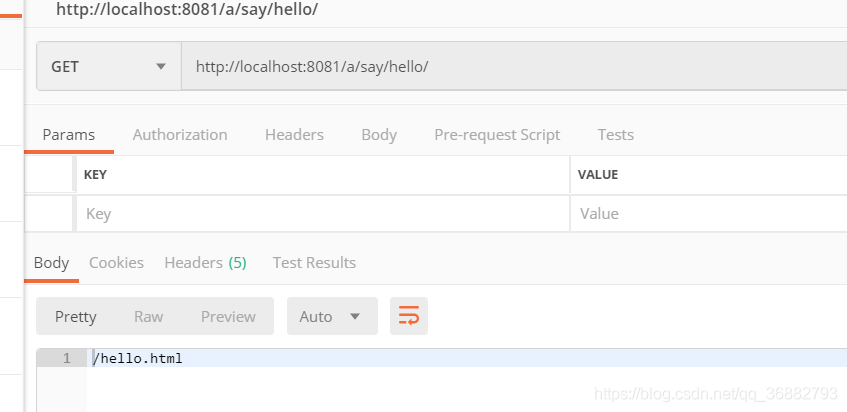这期内容当中小编将会给大家带来有关Java中@RequestMapping注解有什么用,文章内容丰富且以专业的角度为大家分析和叙述,阅读完这篇文章希望大家可以有所收获。
一、前言
问题阐述:在某一场景下,我们的代码在 Service 实现相同,但却在 Controller 层访问时却希望不同的前缀可以访问。如下 :/say/hello。我们这里希望在不借助任何外部服务的情况下 通过 /a/say/hello 和 /b/say/hello 都可以访问到该接口,同时不想在 Controller 中写两个方法。
@RestController@RequestMapping("say")public class SayController { @Autowired private SayService sayService; @RequestMapping("hello") public String hello() { return sayService.hello(); }}二、代码实现
我们这里简单说明一下思路:
在 Spring 服务启动后, HandlerMapping 的实现类 RequestMappingHandlerMapping 会获取到被 @RequestMapping等请求注解修饰的方法,并封装成一个个 HandlerMethod 保存到 RequestMappingHandlerMapping#MappingRegistry 中(HandlerMapping 具有多个实现类,每个实现类具有不同规则)。
当 DispatcherServlet 接收到请求后会根据 url 获取 合适的 HandlerMapping 组成 HandlerExecutionChain(处理器执行链),随后通过 HandlerAdapter 来进行请求处理。而这里通过 HandlerMapping 会根据请求 URL 获取到匹配的 HandlerMethod 进行方法调用。
因此我们这里有了两种思路 :
在 Spring 加载 HandlerMethod 时设置当前 HandlerMethod 的匹配规则为 /a/say/hello/、/b/say/hello/,当 /a/say/hello/、/b/say/hello/ 请求访问时可以与之匹配。
在请求处理的时候,通过拦截器将 /a/say/hello/、/b/say/hello/ 的访问路径匹配到 /say/hello 方法上。
本文选择第一种思路(不过话说怎么想都是第一种好吧)做一个简单demo示例,其实现如下:
// 自定义分发注解@Target({ElementType.TYPE, ElementType.METHOD})@Retention(RetentionPolicy.RUNTIME)@Documentedpublic @interface RequestRouter { String[] value() default "";}package com.kingfish.springjdbcdemo.config;import lombok.SneakyThrows;import org.springframework.stereotype.Component;import org.springframework.web.method.HandlerMethod;import org.springframework.web.servlet.mvc.condition.PatternsRequestCondition;import org.springframework.web.servlet.mvc.method.RequestMappingInfo;import org.springframework.web.servlet.mvc.method.annotation.RequestMappingHandlerMapping;import javax.servlet.http.HttpServletRequest;import java.lang.reflect.Field;import java.lang.reflect.Method;import java.util.Arrays;import java.util.Set;import java.util.stream.Collectors;@Component("handlerMapping")public class RouterRequestMappingHandlerMapping extends RequestMappingHandlerMapping {// 在将 方法封装成 HandlerMethod 时会调用此方法 @SneakyThrows @Override protected RequestMappingInfo getMappingForMethod(Method method, Class<?> handlerType) { // 获取 RequestRouter 注解 RequestRouter requestRouter = method.getAnnotation(RequestRouter.class); if (requestRouter == null) { requestRouter = handlerType.getAnnotation(RequestRouter.class); if (requestRouter == null) { for (Class<?> handlerTypeInterface : handlerType.getInterfaces()) { if ((requestRouter = handlerTypeInterface.getAnnotation(RequestRouter.class)) != null) { break; } } } }// 调用父类,生成 RequestMappingInfo RequestMappingInfo mappingForMethod = super.getMappingForMethod(method, handlerType); if (requestRouter != null) { // 如果 requestRouter 不为空,则进行路径处理 String[] requestRouterValue = requestRouter.value(); PatternsRequestCondition condition = mappingForMethod.getPatternsCondition(); // 获取当前方法匹配的路径,随即进行添加处理。 Set<String> patterns = condition.getPatterns(); Set<String> routerPatterns = patterns.stream() // 拼接 请求路径。这里可以自定义处理策略 .flatMap(pattern -> Arrays.stream(requestRouterValue).map(val -> "/" + val + pattern)) .collect(Collectors.toSet()); // 将拼接后的路径添加到 RequestMappingInfo 中 patterns.addAll(routerPatterns); } return mappingForMethod; }}@Configurationpublic class SpringConfig { @Bean public DispatcherServlet dispatcherServlet(){ DispatcherServlet dispatcherServlet = new DispatcherServlet(); // 禁止加载所有的handlerMapper,而只加载beanName 为 handlerMapper 的bean dispatcherServlet.setDetectAllHandlerMappings(false); return dispatcherServlet; }}这里需要注意 :
HandlerMapping 在 Spring中有多个实现,而 dispatcherServlet.setDetectAllHandlerMappings(false); 参数设置Spring 放弃加载多个 HandlerMapping,而只加载 beanName为 handlerMapping 的
HandlerMapping。RequestMappingInfo 包含 当前方法的诸多信息,其中就包含 什么样请求路径可以匹配到该方法,所以我们在这里获取到 RequestRouter 的信息,并添加到匹配路径上。
三、效果
在 方法上加上 @RequestRouter(value = {"a", "b"}) 注解
@RestController@RequestMapping("say")public class SayController { @Autowired private SayService sayService; @RequestRouter(value = {"a", "b"}) @RequestMapping("hello") public String hello() { return sayService.hello(); }}/a/say/hello/、/b/say/hello/ 以及 /say/hello/ 都可以访问


Java是什么
Java是一门面向对象编程语言,可以编写桌面应用程序、Web应用程序、分布式系统和嵌入式系统应用程序。
上述就是小编为大家分享的Java中@RequestMapping注解有什么用了,如果刚好有类似的疑惑,不妨参照上述分析进行理解。如果想知道更多相关知识,欢迎关注编程网行业资讯频道。






